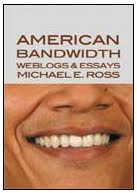You remember Y2K. In the runup to the millennium changeover, a broad fear spread across the country that at the stroke of midnight on Dec. 31, 1999, as the odometer rolled over into 2000, the nation and maybe the world would be plunged into primordial night, leaving us with our bottled water, duct tape and freeze-dried chicken to stumble in the darkness with no electrical grid to help us get to where we needed to go.
In the end, though, it was sound & fury signifying not a damn thing; the fears were groundless, and even comical, and not long after it all happened Americans looked back ruefully and wondered how they could have ever been so gullible.
Fast forward to Y2K6. Yesterday, a significant number of the nation's immigrants, and almost certainly many of the estimated 11 million illegal immigrants, marched in cities throughout the U.S., calling for immigration rights and reform -- including, one assumes, the right not to be presumptively criminalized for seeking a better life for themselves and their families.

It seemed to catch the country almost by surprise, despite the anticipation on the part of politicians, police and, no doubt, immigration officials. More than 1 million people, including Latinos, other immigrants and their supporters, took the day off and hit the streets, showing off their increasing economic clout in a nationwide boycott that slowed work down or shut work off at farms, factories, markets, restaurants and the Port of Los Angeles.
The police departments of more than two dozen U.S. cities contacted by The Associated Press -- from L.A. to Chicago, Houston to Miami -- provided crowd estimates that totaled about 1.1 million marchers.
And just in case there's any confusion about Latino Americans understanding What It All Means, Melanie Lugo, who attended a rally in Denver with her husband, their third-grade daughter and 75,000 other people, clearly gets it.
“We are the backbone of what America is, legal or illegal, it doesn’t matter,” she told the Associated Press. “We butter each other’s bread. They need us as much as we need them.”
That's the assessment of one of the people making a bottom-line difference in America, one of the people who, according to The Washington Post, have a combined purchasing power in the United States of almost $800 billion. And that's expected to rise to about $1 trillion by 2010.
It's facts of that kind that will ultimately frustrate the hard-core ideologues, the Sensenbrenners and Tancredos who can't or won't see past the letter of the law to gain an appreciation for its spirit, and how this country's 42 million Latino Americans are transforming America with their belief in America, their unshakeable faith in what that Emma Lazarus poem is all about.
 The challenge going forward will be to balance the legitimate concerns that many Americans have -- scarily porous borders, the potential for terrorism, the risk of increased drug trafficking and other social ills -- with recognition of immigrants' contributions to the national economy and culture, as well as a need for the pluralism and diversity that make this country what it's always been, or at least what it's long purported to be.
The challenge going forward will be to balance the legitimate concerns that many Americans have -- scarily porous borders, the potential for terrorism, the risk of increased drug trafficking and other social ills -- with recognition of immigrants' contributions to the national economy and culture, as well as a need for the pluralism and diversity that make this country what it's always been, or at least what it's long purported to be.So enough of this silly, emotional discussion of constructing a miles-long, yards-high wall along the southern border with Mexico -- a proposal that offers nothing so much as the prospect of turning the southernmost United States into a North American version of the West Bank.
Like it or not, the unruly, exuberant, genially amped-up hordes that demonstrated across the nation is the look of the American future. And quiet as it's been kept, it's hardly a new look. The Latino impact on the United States has been happening for generations.
It's obvious on any sweltering uptown summer night in New York City, when you're as likely to hear Spanish-language radio out on the street as anything in English.
It's clear to any baseball fan who's observed the steadily inclining arc of excellence as Latino players have become more of a critical mass in the majors than ever before.
It's as plain as la nariz en su cara. The United States has a future with an accent. Make your reservations for Spanish 101 now ... avoid the rush.
-----
Image credit: Andy Thayer (released to public domain)






No comments:
Post a Comment